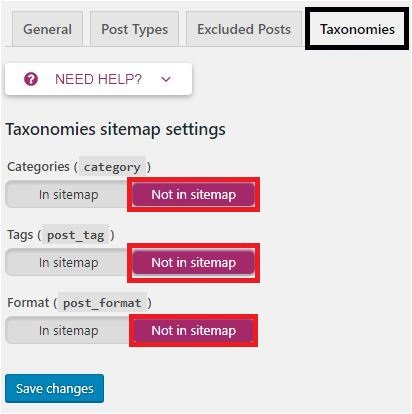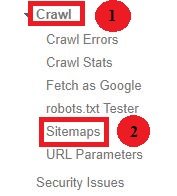When it comes to SEO, adding your site to Google is your first task. But you shouldn’t forget XML-Sitemap.
In fact, it’s mandatory to create an XML sitemap and submit that to Google or other search engines because there are so many SEO benefits of an XML sitemap. One can create it by using ‘Sitemap generator tools’ or plugins.
There are tons of free sitemap generator tools that you can use to create an XML sitemap. By using it, you can improve your SEO.
In this article, I will discuss everything that you need to know about ‘what is a sitemap? How to create an XML sitemap and improve the SEO.
Let’s start with the basic thing…
What is a sitemap in SEO?
Sometimes it is called ‘Google sitemap’. It’s a map of your site that contains all the published web-stuff. Google said that a sitemap improves the crawling of your site.
Do sitemap help SEO? Don’t know, keep reading.
Earlier, you had to submit the different-2 formats of your sitemap. But, Google has changed it. You can now submit the single XML format that takes care of everything. But if you’re running a big business having tons of pages then separate your sitemaps accordingly.
By the way, there are six types of sitemaps
- Index sitemap: This is similar to your site’s homepage. It contains all kinds of sitemaps corresponding to your content category. For example, you have a website with a couple of different- 2 types of Gallery, videos, pages, posts, etc. In that case, you need to create a separate sitemap for every category. Once done, it’s time to include all these sitemaps in the index-sitemap.
- XML sitemap: This kind of sitemap is suitable for search engines. It should be separated so that you can quickly identify your indexing errors. You can again categorize it depending on content types.
- Post XML sitemap: contains all published posts
- Page XML sitemap: includes all printed pages
- Visual/image sitemap: Mostly used by photography bloggers to structure all the images present on your site. It helps search engines to rank every picture on google image search.
- Video sitemap: it’s better to have a separate video Sitemap to manage videos. It helps search crawlers to crawl video content on your site. It also enables you to make your video URL searchable. (Read more about Video sitemap)
- HTML sitemap: This is a map designed to help users with easy navigation. This one is not essential but having one is great for the user experience.
- If your site targets different languages then it’s good to have a separate sitemap to let Google know that your page supports hreflang (Read all about this type of Sitemap from here)
- RSS/Atom feed sitemap: This is used by news sites to get instant indexing. It is shorter than the XML sitemap and contains only 10 to 20 latest posts. Mostly used as a standard format for creating the sitemap in BlogSpot/blogger blogs.
Most of the SEO experts say that submitting your sitemap to Google may help you to index pages instantly.
But I think this is not the way how Google deals with a sitemap. According to MOZ, your pages can’t be found on google by just submitting your sitemap. A sitemap is only a clue for Google to ensure that these are the webpage’s URLs that you want to index. The rest of the process depends on google whether or not they index your pages.
One thing I would recommend you that always submit an XML sitemap instead of an HTML sitemap because all the giant search engines support the protocol specified by sitemap.org.
Sitemap protocol 0.9 is used by Google which means your sitemap should start from the following tag: –
“<urlset xmlns=”http://www.sitemaps.org/schemas/sitemap/0.9″>”
Why does Google like Sitemap?
- Because it’s an organized way to serve your content to the search engine.
- A good sitemap can reduce the crawl efforts.
- Ease of navigation
- It’s become easy for Google to collect the data.
- Having separate sitemaps according to the type of content may improve your search results. Like video content goes to a video sitemap, image content goes to an image sitemap, and so on. This kind of separation significantly influences your SEO.
So, now you know what is a sitemap and also its types. Ok, let’s move on to the next level to get more insights about sitemap.
First of all, let’s talk a bit about these essential tags used in an XML sitemap.
- Location: – Syntax is ‘<loc>http://yourdomain.com</loc>’. It defines the root location of all URLs available in your sitemap. Helps Google to know that from where these URLs belong.
- Last modified: – Syntax is <lastmod>2017-01-01</lastmod>. Every time you modify your post is notified by this syntax and dynamically change the date of updating. It tells the google that ‘XYZ’ post has updated on the corresponding date.
- Change frequency: – Syntax is <changefreq>weekly</changefreq>. It tells Google that how often you update your post. Only a valid update is considered. If you are modifying some text or adding some additional text then only it considered as a valid update.
- Priority: – syntax is <priority>0.4</priority>. It’s a number from 0 to 1 which tells the priority of the post. Maximum priority shows that the popularity of that particular post on search.
Google always prefer those sites that follow Google’s SEO guidelines. A sitemap is one of those recommendations to follow.
Again, remember that the indexing process is not just taking care of Sitemap. There are a bunch of other things that matter. Google never index those pages that aren’t worth indexing.
So, you can only see the SEO effect of sitemap if your site has quality content. Believe it or not, it influences your SEO.
Attention: 40 SEO Factors that affect the domain authority
What is the purpose of having one XML sitemap?
Because crawlers can easily read sitemap and XML makes it easier for crawlers. XML is a markup language that can quickly be scanned by crawlers.
It tells crawlers that when you publish articles and How often you update them.
Neil Patel says that ‘If you are not using the sitemap, your website could be seen as containing duplicate content.’
Like I said at the beginning, the XML sitemap gives a clue to Google. Either you notify google or wait until Google informs you. So, make your decision wisely.
11 Benefits of having a Google sitemap/XML sitemap
- Ease of Crawlability
- Deep and hidden URLs can be easily identified by crawlers
- Helps to organize an extensive list of URLs and make it easy for search engines to find and crawl
- It helps you to build a critical external link profile, which is helpful from SEO perspectives.
- Make internal linking scenario strong
- Changes dynamically take effects on sitemap and make your crawling list up to date.
- Make the crawling process search engine friendly.
- XML sitemap shows Google the importance of your content.
- Reduce the chances of duplicity.
- Once you have submitted the XML sitemap to the Google search console, it will help you found out the crawl error, warnings and also facilitate you to make them fix.
- It helps you categorize your content accordingly, which makes the search engine’s crawling path short.
SEO benefits of XML sitemap
- If you publish articles on a daily basis, then it might happen that Google couldn’t find some of your pieces. Resulting, no crawling & indexing. Instant indexing is also a part of SEO. So, it’s a good idea to have an XML sitemap.
- It reduces the chances of getting penalized. It’s true that Google doesn’t like duplicate content because if someone has copied your content and published it to on his blog that time, XML sitemap plays an important role. It tells Google that ‘XYZ’ content was correspondence to ‘ABC [name of author]’ author and posted at this exact time and location. So, one XML sitemap could impact your authorship and boost SEO regarding quality.
- Using an XML sitemap reduces indexing time and keep it in between 3 to 5 hours. Means Google will index your latest content in just 3-5 hours which could be up to 2 to 3 days without having a sitemap.
Finally, you have understood the SEO benefits of an XML sitemap. Now, it’s time to take a step up and learn how you can create an XML sitemap.
A step-by-step guide to creating an XML sitemap for WordPress users
It’s pretty easy for WordPress users to create an SEO optimize XML sitemap. There are many plugins that you can install. But I recommend these two plugins
If you’re using the Yoast plugin, then you don’t need to install another plugin. Yoast automatically creates an XML sitemap keeping SEO in mind. You don’t need to worry about further SEO optimization.
Its’ totally up to you which plugin do you want to use. I like Yoast SEO. If you also like then keep on reading. I’ll tell you how to create an XML sitemap using the Yoast plugin.
Attention: How to set up the Yoast SEO plugin
First of all, install the Yoast SEO plugin, and Next, Head to Yoast SEO > XML sitemap > enable the sitemap functionality
After allowing, click the XML sitemap button. It will take you to the index page of the XML sitemap. Make these customizations according to these screenshots.






Once you have followed these instructions, you’ll end up with SEO optimized sitemap. But what if you are on BlogSpot, Don’t worry I’ll discuss it separately.
A step-by-step guide to creating a sitemap for BlogSpot/Blogger users
Unfortunately, there is no plugin for BlogSpot users. But luckily, these alternatives can help you generating XML Sitemap for Blogger sites.
Use the following free sitemap generator tools to generate an entirely SEO optimized sitemap
- XML sitemap for blogger [By Amit Agrawal]: – A valid URLs must contain blogspot.com
- Blogger sitemap generator
- Manually method: You don’t need to create any sitemap. Just copy the following URL
http://yourdomain.com/atom.xml?redirect=false&start-index=1&max-results=500 [only valid up to 500 urls]
To create a sitemap that contains more than 500 URLs, submit these sitemaps on the google search console one by one. [Don’t forget to replace your domain with ‘yourdomain.com’ ]
http://yourdomain.com/atom.xml?redirect=false&start-index=1&max-results=500
http://yourdomain.com/atom.xml?redirect=false&start-index=501&max-results=500
If you don’t want to do it manually, then don’t worry. You can use the first method to do the same. See how you can generate a sitemap for blogger instantly.
Step – 1
Go to Blogger sitemap generator tool
Put your website URL and hit enter [Your URL must have blogspot.com. Also remember that even if you have purchased a custom domain, your domain should have a standard blogger extension ‘blogspot.com’].
For example, suppose your standard domain is ‘example.blogspot.com’. After a while you purchase a custom domain say ‘mycustomdomain.com’ and redirects the example.blogspot.com domain to mycustomdomain.com. Then you need to put in ‘example.blogspot.com’ instead ‘mycustomdomain.com’
Within a second, it will show you the text that you need to copy.

Step – 2
Head to the Blogger Dashboard > settings > search preferences > custom Robot.txt and copy the earlier text to the robot.txt file.


Click the save button. That’s it.
Step – 3
Now, it’s time to submit the sitemap to Google. For that, copy all sitemap URLs and submit those to the Google search console one by one.
http://example.blogspot.com/atom.xml?redirect=false&start-index=1&max-results=500
http://example.blogspot.com/atom.xml?redirect=false&start-index=501&max-results=500
http://example.blogspot.com/atom.xml?redirect=false&start-index=1001&max-results=500
http://example.blogspot.com/atom.xml?redirect=false&start-index=1501&max-results=500
http://example.blogspot.com/atom.xml?redirect=false&start-index=2001&max-results=500
http://example.blogspot.com/atom.xml?redirect=false&start-index=2501&max-results=500
http://example.blogspot.com/atom.xml?redirect=false&start-index=3001&max-results=500
The above sitemaps are generated by the blogger sitemap generator tool. If your website has less than 500 URLs, then you’ll find only one sitemap. [Above site contains 3500 URLs, that’s why it has seven sitemaps]
Once you copied all sitemaps from your clipboard, it’s time to switch to ‘Google webmaster tool or Google search console’.
And click crawl > sitemap > submit sitemap


Repeat the same process for the remaining sitemaps.
By the end of reading this guide, you’ve come to know what a sitemap is? And how to submit it to Google. You can follow the same process to submit the sitemap to all other search engines. However, there could be some other online sitemap tools that you can use to create a sitemap for Bing, Yandex, etc.
Now, I want to give you some tips that can help you optimize your sitemap for SEO.
Sitemap SEO best practices
- Your index-Sitemap shouldn’t be larger than 10 MB
- Create a separate sitemap for different- 2 categories like images, videos, posts, and pages, etc.
- Keep your sitemap clean. It means never put blocked URLs in it. It may negatively affect your SEO.
- Don’t forget to submit your sitemap to Google, Yahoo, Bing, and Yandex, etc.
- If you are using WordPress, then use Yoast by SEO plugin because it provides you one-click configuration and ease of sitemap maintenance.
- Blogspot users can use the ‘online sitemap generator tools’ to create the desired sitemap. Before submitting, check the sitemap whether it is ok or not. [either uses the above method to create one]
- Exclude URLs of duplicate content from the sitemap. It might confuse Google bots and may negatively impact your SEO.
- Never include utility pages that are not essential for search results like contact us, privacy policy, etc. These are helpful for users.
- Google recommends you use both XML & RSS/Atom sitemaps because XML sitemaps are bigger than RSS and may take more time to load. But RSS sitemaps are short and contain only some latest articles. RSS sitemap is notifying google much faster than XML sitemap.
- Exclude the thin content, tags, categories from your sitemap to enhance the sitemap quality
Conclusion: –
It’s always advisable to create an XML sitemap for big web Directories because it helps you speed up your indexing and SEO as well.
But it doesn’t mean that you should skip it for small sites. A well-optimized XML sitemap makes your site healthier than others.
Everything that can improve search visibility, ranking, and indexing will ultimately enhance SEO. So, if you’re missing this opportunity, I don’t think you could survive in this critical SEO world. So, don’t wait just go ahead and create one for your site.
If you’ve missed something regarding the sitemap, don’t worry I have covered every single step that you need to take for creating the sitemap.
I hope you would find this guide helpful. If yes, don’t forget to share on Facebook, Twitter, Reddit, and LinkedIn.
What do you think about Sitemap? Share your experience.










3 thoughts on “SEO Benefits of XML Sitemap: A Guide To Create Google Friendly XML Sitemap”
Thanks! you have explained it nicely.
Great…!! nice artical very usefull your post Thank you so much for sharing this and the information provide.
Thanks for the amazing articles. I have two quick questions:
Am I wrong in uding blogspot for teaching tech stuff, tutorials, projects?
To submit sitemap xml only after posting around 500 blog posts?